May 31, 2010
May 30, 2010
Creating Video Portfolios with Flash Catalyst
May 29, 2010
Slideshow without keyframes in After Effects
 EfectoHD shares his process and project files for making a slideshow of photos without keyframes in After Effects:
EfectoHD shares his process and project files for making a slideshow of photos without keyframes in After Effects:"More than a tutorial, this is the explanation of a technique that I can be of use when creating these slideshows easy in After Effects without creating not a single keyframe.The technique involves creating a series of zero, each with a basic motion: zoom in, zoom out, panning left, panning right ... all with a constant speed then we will provide a basis to encourage the photos." ...via Lester Banks.
 For other options on slideshows, click the tag slideshow, which includes an After Effects tutorial by Lloyd Alvarez at AEtuts, Create A Rockin’ Automated Slideshow and the Video Copilot tutorial 12. Elegant Slideshows. See also a Simple gallery in 3D not using the cylinder effect-- Tutorial After Effects by "The Great Zimm."
For other options on slideshows, click the tag slideshow, which includes an After Effects tutorial by Lloyd Alvarez at AEtuts, Create A Rockin’ Automated Slideshow and the Video Copilot tutorial 12. Elegant Slideshows. See also a Simple gallery in 3D not using the cylinder effect-- Tutorial After Effects by "The Great Zimm."
News gap Saturday
 RSS to Twitter delay, so let's call it Saturday...
RSS to Twitter delay, so let's call it Saturday...Several tutorials, tips, scripts, and news items were mentioned around the web not discussed here at AEP. Here's some websites and resources with a different mix of news this week:
- "Say no to presets and tutorials! All works end up looking the same. Realize that your weakness *is* your strength." -- a Zen Mind, Beginner's Mind type tweet from Peder Norrby of Trapcode (@rymden). [Later, a discussion ensued at Trapcode Facebook, and Peder explains Your weakness is your strength at the Trapcode blog.]
- These sites has several items... @hashae, AE Tuts, Lester Banks, motion graphics eXchange
- Todd Kopriva notes several character animation tutorials (and more) from Robert Powers and looks at both the forest and trees in Tutorials for After Effects and 3D by Dave Scotland.
- Stereo 3D tutorials are coming to Video Copilot
- VFX Haiku video Journey to the Center of the Earth 3D: Stereo Workflow
- Nonlinear Disparity Mapping for Stereoscopic 3D tech on stereo framing & perception
- After Effects CS5 - 3D Stereoscopic by David Smith of Academy Class
- AFTER EFFECTS 3D stereoscopic camera tutorial by "The Great Zimm" aka "Adam Meyers."
- Several 2010 Christoph Keller tutorials are favored by many, for example, Stereo-3D Scripts for After Effects
- 3D Thursday is a new series of round-ups of inspirational pieces based on 3D (not stereo 3D) on Motion Design Love.
- After Effects filters for CS5 continue to be released, including Genarts Sapphire and sets from RE:Vision Effects, Video Copilot, and others. AE product manager Michael Coleman recommends keeping track of 64-bit plug-ins for After Effects CS5 with the recent list at the After Effects plug-in page on Adobe.com.
- Other updated CS5-compatible lists include Mylenium's list at his After Effects Plug-in Guide and Toolfarm's list of 64-Bit Plug-ins.
May 28, 2010
Tutorials for After Effects and 3D by Dave Scotland
 Todd Kopriva takes a close look at tutorials for After Effects and 3D by Dave Scotland and adds some meta-commentary.
Todd Kopriva takes a close look at tutorials for After Effects and 3D by Dave Scotland and adds some meta-commentary.Todd has similar looks at the Video Copilot Basic Training series, Steve Holmes Artbeats podcast, and Pete O'Connell on Rotoscoping in After Effects.
Mattrunks camera and animation work for Netvibes
 via @maltaannon, Mattrunks describes his camera and animation work for Netvibes Showcase in Netvibes Showcase 2010, my last achievement! (translated acceptably by Google). He leveraged Maltaannon's Single Camera Rig and the Ease and Wizz script palette, and adds a variety of tips.
via @maltaannon, Mattrunks describes his camera and animation work for Netvibes Showcase in Netvibes Showcase 2010, my last achievement! (translated acceptably by Google). He leveraged Maltaannon's Single Camera Rig and the Ease and Wizz script palette, and adds a variety of tips.Since Mattrunks very creative tutorials are only in French and under a Creative Commons license, someone might post these to Youtube to get transcribed captions in English -- though any alteration or transformation requires a license identical to the one used by Mattrunks.
There's more via the tag AE camera, including alternatives to Maltaannon's script like Sure Target (Videocopilot's free AE plug-in) and a script by Hypoly that works with Sure Target. Here's the Netvibes Showcase:
Netvibes Showcase from Netvibes on Vimeo.
28 Tracking and Matchmoving Tutorials
 Topher Welsh has collected 28 Tracking and Matchmoving Tutorials for AEtuts. There doesn't seem to be anything new, but it's a convenient supplement to his March collection, 28 Magnificent Mocha Tutorials.
Topher Welsh has collected 28 Tracking and Matchmoving Tutorials for AEtuts. There doesn't seem to be anything new, but it's a convenient supplement to his March collection, 28 Magnificent Mocha Tutorials.For AEP resources on tracking, including CS5 resources and intros from Fxguide and Vfx Masters, click on the tag tracking.
Moving After Effects render templates
 Tim Clapham (@helloluxx) has a new After Effects tip, Moving AE Templates, which reminds you how you can move Render Setting and Output Module Templates in After Effects.
Tim Clapham (@helloluxx) has a new After Effects tip, Moving AE Templates, which reminds you how you can move Render Setting and Output Module Templates in After Effects.May 27, 2010
Magic Bullet Grinder: Mac app for Canon DSLR conversion
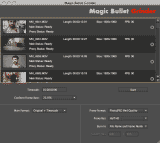 Magic Bullet Grinder (US$49) is a new standalone application for the Mac that batch processes footage from a Canon DSLR:
Magic Bullet Grinder (US$49) is a new standalone application for the Mac that batch processes footage from a Canon DSLR:"It can convert to ProRes, add timecode, and even create low-res with window burn proxies for offline editing. You can also use it to conform (not convert, i.e. no frame blending or motion interpolation) a bunch of clips to one frame rate, so your 30p and 60p shots can become slow-mo clips at 23.976fps."
Update: Stu Maschwitz responds to comments on his blog,
"Why did we make something to compete with all the free options [Mpeg Streamclip, EOS 5d FCP log and transfer plug-in, etc.] out there?
Grinder's strength is its singularity of purpose and its simplicity. Yes, there are many free ways to convert media files. Some are easier to configure than others. Grinder is a zero-config, drag-and-drop app with a few carefully-chosen options custom-tailored for the needs of HDSLR shooters.
It doesn't do much that's unique, but one feature it has that I like a lot is the parallel proxy rendering. I like to work with low-res offline clips with TC window burn and then master back to my camera originals. Grinder makes that a breeze.
Frame-rate conform is another biggie. I love that I can go shoot 24, 30, 50 and 60p and conform it all back to 23.976 without any effort. Makes slow-mo a simple thing.
Grinder is not expensive. It's for people who want something that works right every time with no fuss."
Plus, there's already a review on PVC.
Update 2: of course if you're using CS5, AE CS5 and Premiere Pro CS5 both natively support DSLR footage. Video backgrounders can be found in AEP posts Native DSLR Editing in Premiere Pro CS5 and Keying, Time Remapping, & Stills in Premiere CS5.
Update 3: there's a public beta of 5DtoRGB, which converts Canon EOS series video files to high-quality DPX sequences or ProRes QuickTime files.
May 26, 2010
Unplugged 25: Noise Industries interview + free filters
 Motionworks' Unplugged 25 features an interview with Niclas Bahn of Noise Industries:
Motionworks' Unplugged 25 features an interview with Niclas Bahn of Noise Industries:"Noise Industries offers a range of [Mac-only] GPU-accelerated plug-ins for After Effects and Final Cut. In this episode Niclas Bahn demystifies the FX-Factory platform and introduces three of the key plug-in packs available from Noise Industries, including FX Factory Pro, MoType and Nodes."
Note: Noise Industries offers several Free Plug-Ins, including CoverFlux for an iTunes Cover Flow (or CoverFlow) look and Pan and Zoom for the Ken Burns effect. There's more free FxPlug filters listed by @juanmiguelsalas, Pure & Applied, and Scott Simmons and The DV Show -- and others are available through the same links if that list is limited. [Update: there's also the new Freebie Pack 1 from idustrialrevolution.]
If you're on Windows an easy way to do the Cover Flow effect is with an After Effect script by Paul Tuersley. You just have to animate some sliders.
May 25, 2010
Update for CS5 RED plug-ins
 CS5 includes built-in support for the RED camera format, and today there's an update to the RED camera import CS5 plug-ins for After Effects and Premiere Pro to include support for the new Mysterium-X sensor and the latest "Color Science."
CS5 includes built-in support for the RED camera format, and today there's an update to the RED camera import CS5 plug-ins for After Effects and Premiere Pro to include support for the new Mysterium-X sensor and the latest "Color Science." Details are provided by Todd Kopriva in his post new RED color science, and how to make it all work with After Effects CS5 and Premiere Pro CS5.
Scrolling LED Text in After Effects
You can download the project file along with an MP4 version of the tutorial. Here's an example:
Scrolling LED Text Tutorial Preview from Quba Michalski on Vimeo.
May 24, 2010
Video Copilot Optical Flares in review
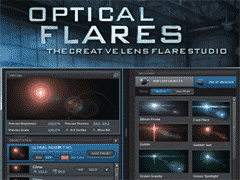 [update: Toolfarm is having a Video Copilot Sale -- 30% on ALL Video Copilot products Wednesday and Thursday, May 26 & 27, 2010 only.]
[update: Toolfarm is having a Video Copilot Sale -- 30% on ALL Video Copilot products Wednesday and Thursday, May 26 & 27, 2010 only.]Video Copilot has released CS5 compatible versions of their After Effects filters -- free upgrades (OF, others, + update) from the previous versions. The standout among these is Optical Flares, a newer plug-in that leapfrogs longtime industry leader Knoll Lens Flare Pro in interface and features for about 1/3 the price. Here's a demo:
Andrew Kramer and company have taken a page from the Magic Bullet Looks approach to create a powerful and easy-to-use interface. The custom interface offers drawers full of visual presets and detailed control over individual flare elements, as well as a large adjustable preview of the composite or the flare alone. The advanced UI along with GPU acceleration allows users to build, edit, and manage unique and complex lens flares with speed and simplicity.
All of these features and more are built into this one plug-in:
- 3D lens flares with AE Lights
- 2D + 3D occlusion or obscuration
- edge flare-ups
- auto-tracking
- auto-animation
- textures
- matte box
Knoll Lens Flare Pro (which is not available for CS5 until summer 2010) has offered most of the same features with the addition of public beta releases, but without the integrated visual interface. Perhaps KLF's sole remaining advantage is that in addition to the main filters, 19 lens elements are also included for minute control over parameters, though you should be able to get similar control in Optical Flares using presets. For now, Optical Flares is an After Effects-only filter, but it is said that versions for NLEs, Photoshop, Fusion, and Nuke are under consideration.
 If you don't have a dedicated lens flare filter, and there are only two in this league, you're in for a treat. Overuse of lens flares is common though -- but with a filter like Optical Flares, you can rise above the common cliche of the Photoshop default (at left). Individual flare elements can be used as the base, as seen almost everywhere, or as elements of design.
If you don't have a dedicated lens flare filter, and there are only two in this league, you're in for a treat. Overuse of lens flares is common though -- but with a filter like Optical Flares, you can rise above the common cliche of the Photoshop default (at left). Individual flare elements can be used as the base, as seen almost everywhere, or as elements of design.Use in more realistic shots may take some extra observation and self-control. Tony Reale recently introduced ideas on using lens flares in edits in his After Effects tutorial Add Anamorphic Lens Flares to Video. There's a lot going on beyond the basics with lighting, camera filters and lenses, etc. and lens flares can become obsessions to avoid, create, or recreate. One good resource for study is a cache of QuickTime movies of real world lens flares by Claudio Miranda.
Another obvious resource is J.J. Abrams' "ridiculous" use of kinetic halos in the latest Star Trek movie (Andrew Kramer did the titles). See various discussions of these mostly in-camera effects done by cinematographer Dan Mindel in Where No DP Has Gone Before at ICG Magazine, and more about ILM custom matching "SunSpot" CG in Back on Trek (Flare Madness) at Millimeter & Star Trek Returns at Post Magazine.
 As a sort of an addendum, it's interesting to see how the idea grew for 3D lens flares in After Effects. From at least 2004, there were forum requests for help to go beyond parenting to a 3D layer. AE expression guru Dan Ebberts provided examples at MotionScript and explained a bit more about layer space transforms, which were also discussed by Chris Meyer not long ago at PVC. A few years later Mylenium's Building a Lensflare with Expressions (and Trent Armstrong's Making Light Disappear & Reappear Behind Objects Using Expressions) appeared at Creative Cow. Then in 2009, Andrew Kramer spread the idea further in Lens Flare on 3D Lights? and the race was on to incorporate 3D lens flares into an After Effects filter.
As a sort of an addendum, it's interesting to see how the idea grew for 3D lens flares in After Effects. From at least 2004, there were forum requests for help to go beyond parenting to a 3D layer. AE expression guru Dan Ebberts provided examples at MotionScript and explained a bit more about layer space transforms, which were also discussed by Chris Meyer not long ago at PVC. A few years later Mylenium's Building a Lensflare with Expressions (and Trent Armstrong's Making Light Disappear & Reappear Behind Objects Using Expressions) appeared at Creative Cow. Then in 2009, Andrew Kramer spread the idea further in Lens Flare on 3D Lights? and the race was on to incorporate 3D lens flares into an After Effects filter.Update: Kevin McAuliffe wrote a substantive review of Optical Flares for ProVideo Coalition.
Update: Johan Romera shared Nuke2AE Optical Flares Gizmo, a Nuke script that corverts 3d data to 2d position to create AE keyframe data for Optical Flares.
May 21, 2010
Optical Flares Random Color Adjustment
Optical Flares for CS5 is expected any day now.
Optical Flares Random Color Adjustment Tutorial from Dan Hostler on Vimeo.
May 20, 2010
Freeware video file analyzers
 A thread on the After Effects-List, mentioned several freeware video file analyzers beyond the obvious information functions in Quicktime and VLC media player:
A thread on the After Effects-List, mentioned several freeware video file analyzers beyond the obvious information functions in Quicktime and VLC media player:- MediaInfo (Windows, Mac, UNIX/LINUX)
- MediaInfo Mac
- VideoSpec (AppleScript studio App)
- GSpot (Win)
- VideoHelp has a list of mostly Windows utilities, Codec/Video Identifiers
Data Baby & beyond
A few month ago AEP noted some background on Data Baby, a generative graphics spot from IBM. More of the background is fleshed out by Ian Failes of Vfxblog in his Fxguide interview with visual effects supervisor John Fragomeni and art director Angela Zhu.
 Coincidentally, Mitchell Whitelaw considers the same series of commercials at his blog This Teeming Void in This is Data? Arguing with Data Baby.
Coincidentally, Mitchell Whitelaw considers the same series of commercials at his blog This Teeming Void in This is Data? Arguing with Data Baby."Data does not just happen; it is created in specific and deliberate ways. It is generated by sensors, not babies; and those sensors are designed to measure specific parameters for specific reasons, at certain rates, with certain resolutions. Or more correctly: it is gathered by people, for specific reasons, with a certain view of the world in mind, a certain concept of what the problem or the subject is. The people use the sensors, to gather the data, to measure a certain chosen aspect of the world.
[...]
Collapsing the real, complex, human / social / technological processes around data into a cloud of wafting particles is a brilliant piece of visual rhetoric; it's a powerful and beautiful story, but it's full of holes. If IBM is right - and I think they probably are - about the dawning age of data everywhere, then we need more than a sort of corporate-sponsored data mythology. We need real, broad-based, practical and critical data skills and literacies, an understanding of how to make data and do things with it."
This view mirrors earlier arguments in public policy circles on energy and economic modeling and forecasting. See also AEP's How to Lie with Video Data and Smashing Magazine's Imagine A Pie Chart Stomping On An Infographic Forever.
"Film is truth 24 times a second, and every cut is a lie..."
--Jean-Luc Godard
"The camera lies all the time. It lies 24 times a second."
-- Brian De Palma
Update: here's a slight return for The Kuleshov Effect, a montage effect demonstrated by Russian filmmaker Lev Kuleshov, which is explained near the end of the interview with Hitchcock (he explains three types of editing).
commonsExplorer: a browser for Flickr + more
commonsExplorer is a Java executable, so Windows and Linux users will need to have Java installed. The application requires a network connection, and may not work from behind a firewall or proxy.
 Creative Commons has had its own search function for awhile according to a post at Google Operating System, which has a nice cache of articles on new features in Google Image search, which can filter for usage rights under advanced search.
Creative Commons has had its own search function for awhile according to a post at Google Operating System, which has a nice cache of articles on new features in Google Image search, which can filter for usage rights under advanced search.For video, see Free Online Stock Video Footage | 9 Of The Best Public Domain Video Resources from WebTV Wire (one dropped out); for audio see Videomaker's compilation of royalty free sound FX and Legal Music For Videos from Creative Commons.
Update: via @juanmiguelsalas comes 15 Best Places for Designers to Get Free Stock Photos Online by Six Revisions.
Update 2: see Royalty Free Music For YouTube Videos at Who Is Matt, and Openfootage.net.
May 19, 2010
Using a Wacom tablet in After Effects & Premiere
Optimal memory settings in After Effects + faster
 There's a new FAQ from Adobe on optimum memory settings for best performance in After Effects CS4 and CS5. It's really a set of links that includes the Help pages on tips for performance improvement and RAM usage in After Effects.
There's a new FAQ from Adobe on optimum memory settings for best performance in After Effects CS4 and CS5. It's really a set of links that includes the Help pages on tips for performance improvement and RAM usage in After Effects.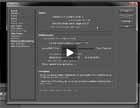 Those pages are detailed and thorough, so it might be good to start with a recent AETtuts quick tip by Won Novalis, Understanding Memory and Multiprocessing, which was 'blessed' by a link from Todd Kopriva.
Those pages are detailed and thorough, so it might be good to start with a recent AETtuts quick tip by Won Novalis, Understanding Memory and Multiprocessing, which was 'blessed' by a link from Todd Kopriva.Update: see also Faster by Michael Coleman.
Keying, Time Remapping, & Stills in Premiere CS5
Note: the Time Warp effect from CS3 and CS4 was removed from Premiere CS5, but there's always Pixel Motion and Time Warp in After Effects if you need better results.
DSLR Workflow in Premiere Pro CS5 - Keying, Time Remapping & Stills from Jason Levine on Vimeo.
Update: Karl Soule added another on DSLR,
May 18, 2010
Muzzle flash tutorials in After Effects
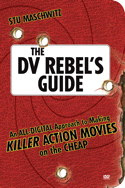 This post has been updated and moved to ProVideo Coalition as Muzzle flashes in After Effects.
This post has been updated and moved to ProVideo Coalition as Muzzle flashes in After Effects.
UI Animation with Inverse Scaling
New Camera RAW features in CS5 + RAW B&W
Also: at TipSquirrel Justin Seeley has a video overview of the new CR, and a Photoshop Quicktip showing why Camera RAW is well-suited for creating black & white photos.
RAW Black & Whites from Justin Seeley on Vimeo.
Call-in hour with the After Effects team is returning
 Adobe After Effects on Facebook says the fireside chat call-in hour with the After Effects team is returning:
Adobe After Effects on Facebook says the fireside chat call-in hour with the After Effects team is returning: "Want to talk to the After Effects team? Fireside chat Thurs 9-10am PST. Call 877-220-5439, use ID 882164 and password 1223334444. You can ask questions or just listen. Chat link below, where you can also ask questions. Topics you want us to yak about between calls? Add a comment! [at] Connect Pro Meeting Log."
Update: Michael Coleman says, "we'll be recording the session and making it available later in the week in case you have to be at your job or something."
May 17, 2010
Omino Spindala: a Pixel Bender Filter
Dave van Brink has also released free Pixel Bender filters Omino Glass and Omino Staragon recently; they work in CS4 or CS5 in 32-bits per channel.
Update: Satya Meka notes that "Omino also has a Cool UV Mapping Pixel Bender Filter for AE with explanation."
May 16, 2010
Paper rip: free After Effects project + tutorial
 Via @MotionDesignLuv and @juanmiguelsalas, lasted year Aharon Rabinowitz posted a free After Effects project that may come in handy, Free After Effects Project File – Page Rip.
Via @MotionDesignLuv and @juanmiguelsalas, lasted year Aharon Rabinowitz posted a free After Effects project that may come in handy, Free After Effects Project File – Page Rip.I forgot how Brian Maffitt created his, so here's a tutorial from Big Mike Design, Paper Rip Effect in After Effects, which uses Photoshop and After Effects, alpha channels, track mattes, precomposing, and CC Page Turn or a similar.
BIGMIKEDESIGN: Paper Rip Tutorial from Mike on Vimeo.
After Effects CS5 installation geekery
 In Nerdism!, Mylemium provides detailed information about After Effects installation directories, installation preparation, and licensing issues -- which also may enhance the value of his After Effects Error Code Database.
In Nerdism!, Mylemium provides detailed information about After Effects installation directories, installation preparation, and licensing issues -- which also may enhance the value of his After Effects Error Code Database.
Camera mapping tutorial
Note: Additional resources on camera mapping and the AE camera can be found by clicking on those tags.
May 14, 2010
Camera fly-thru titles and depth of field
An After Effects to Nuke workflow
"Some people have a difficult time transitioning from a layer based editor like Aftereffects to a node based piece of software like Nuke. This video shows you some of the common problems some people experience when trying to learn a new application.For those of you ambitious enough, the Foundry actually has the whole 1000+ page Nuke manual on their site for free. The file is a PDF and is a must in my opinion if you want to further explore Nuke."
Note: For more on Nuke, see Nuke intro for AE users and more via the tag Nuke. Similar enticements were noted recently in Node-based compositing for After Effects users.
AEP Night in Tokyo May 27
 Tatsuro Ogata (llcheesell), author of the AE script LCDeffect and Japanese website AEP Project, announced an After Effects user group meeting "AEP Night" modeled on AENY. See #AEPN2 for Twitter buzz.
Tatsuro Ogata (llcheesell), author of the AE script LCDeffect and Japanese website AEP Project, announced an After Effects user group meeting "AEP Night" modeled on AENY. See #AEPN2 for Twitter buzz.The event is planned for Tokyo on 27, May, 2010 (Thu) 18:00- 20:30 JST at Station 5 (OW Building 4-21-8 Jingumae, Shibuya-ku, Tokyo). Station 5 is an Adobe's official gallery and event space at Omote-sando, Tokyo (pictured).
The agenda includes seven talks, a short movie competition, & an after party. The talk and competition should be broadcast using Ustream, and there are many join-prizes: CS5 Production Premium, CINEMA 4D Broadcast Edition, FxFactory Pro 2, five Red Giant products, and more.
By the way Google Chrome 4 will automatically ask if you want a translation of a web page; very handy.
May 13, 2010
3D displacement and flag waving in CS5
There's many more examples and tutorials on 3D displacement on the Digieffects and Mettle websites. The only other plug-in in memory that could do this was Cognicon TILT, built to use the defunct Quickdraw 3D from Apple (Red Giant's Sean Safreed was the Apple product manager). Here's an intro to Freeform displacement:
Freeform 3D Displacer - Overview from digieffects on Vimeo.
By the way, special pricing ends tomorrow Friday the 14th 12:00 pm E.S.T. on the FreeForm Enhancement Packs - Mylenium Edition. That's 10 HD Project Files for $79 ; regular price is $179.
 Update: Chris Bobitis added a free flag project using Freeform -- just add some texture or pre-displacement to the flag if you think it has too much starch.
Update: Chris Bobitis added a free flag project using Freeform -- just add some texture or pre-displacement to the flag if you think it has too much starch.Premiere Pro CS5: 6 QuickTip videos
Premiere CS5 QuickTip - Facial Recognition from Evan Butson on Vimeo.
For more: see Native DSLR Editing in Premiere Pro CS5, which also notes that the Premiere Tryout does not include all codecs in the actual software.May 12, 2010
Node-based compositing for After Effects users
Node Based Compositing for After Effects Users - Part 1 from Kert Gartner on Vimeo.
Node Based Compositing for After Effects Users - Part 2 from Kert Gartner on Vimeo.
Noted previously: Steve Wright, author of Digital Compositing for Film and Video, introduced the ideas and methods behind node-based compositing in another video tutorial at Creative Cow. dvGarage has something similar and more in the movie 'Introduction to Nodal Compositing, a part of their free Conduit training.AE script kd_AutoFade also rotates and scales
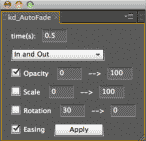 AE Scripts is featuring kd_AutoFade, an After Effects script that can automatically fade your selected layers in and out, rotate and scale the layers, and set easing -- all together or separately.
AE Scripts is featuring kd_AutoFade, an After Effects script that can automatically fade your selected layers in and out, rotate and scale the layers, and set easing -- all together or separately.In some cases this could be quite the timesaver.
May 11, 2010
Artbeats tutorials: transform fire + shatter
 Artbeats has a couple of new After Effects tutorials:
Artbeats has a couple of new After Effects tutorials:Firestarter by Steve Holmes is a new written tutorial, demonstrating After Effects keying and animated masking techniques to turn a simple fire clip into a looping, swirling, boiling mass of fire that can be composited over any background.
Cleft, an After Effects tutorial video by Eran Stern, uses AE and Boris Continuum Complete to create a 3D logo, incorporate stock footage and sound, and add shatter effects for idiosyncratic opener.
After Effects team: submit requests for CS6
 The Adobe After Effects Facebook page says that the AE team was "sitting in a conference room this afternoon, hatching plans for what we'll tackle next. You can submit feature requests ... (we review them all), or comment here to give us a general sense of your priorities."
The Adobe After Effects Facebook page says that the AE team was "sitting in a conference room this afternoon, hatching plans for what we'll tackle next. You can submit feature requests ... (we review them all), or comment here to give us a general sense of your priorities."Maybe better features can be added to existing features in CS Next, with continued refinement of Roto Brush and some massive initiative on the neglected 3D feature set. The inclusion of Freeform was a very nice band-aid though. For several years new 3D features in AE have relied on Photoshop 3D -- which is trumpeted by Photoshop some fans but questioned by AE users familiar with actual 3D applications. It would make more sense if 3D was designed for the higher-end application and flowed down to the more general population; Photoshop users would benefit tremendously too.
NOTE: Please be sure to let Adobe know directly via:
https://www.adobe.com/cfusion/mmform/index.cfm?name=wishform
Knoll Light Factory Pro & Editors Training
1 Intro from Red Giant Software on Vimeo.
Red Giant TV interview with ILM's John Knoll

Aharon Rabinowitz interviewed Industrial Light & Magic VFX supervisor John Knoll for Red Giant.
Update: part 2 is up.
May 10, 2010
Yanobox Nodes: rave review at PVC
 A new design-oriented FxPlug (Mac-only), Yanobox Nodes surfaced not long ago, and Kevin P McAuliffe at PVC has a rave review. He also has a quick intro:
A new design-oriented FxPlug (Mac-only), Yanobox Nodes surfaced not long ago, and Kevin P McAuliffe at PVC has a rave review. He also has a quick intro:Yanobox Nodes from Kevin P McAuliffe on Vimeo.
Update: Noise Industries added a tutorial,
Preference mod widens CS5 CUDA acceleration
 Some simple modification to a Premiere CS5 preference file and to Nvdia preferences can enable CUDA acceleration on more Nvdia cards, according to reports on Premiere forums. This is not driver modification (softmod) or overclocking, but it is unsupported.
Some simple modification to a Premiere CS5 preference file and to Nvdia preferences can enable CUDA acceleration on more Nvdia cards, according to reports on Premiere forums. This is not driver modification (softmod) or overclocking, but it is unsupported.The mod seems to have popped up at DVinfo.com in How to make Premiere CS5 work with GTX 295 and possibly all 200 GPUs by marvguitar/Martin Guitar, and spread elsewhere, including to the Adobe forum at Unsupported GPU for CS5.
On Windows, the "GPUSniffer.exe" looks at "cuda_supported_cards.txt" to match the named list of cards with your GPU, so it's just a matter of enabling your card and seeing what works. Adobe has made details on CUDA acceleration and supported cards pretty clear from the start in order to create a pipeline with higher performance, quality, and reliability guarantees. There are plans for more cards to be certified in future but it will take Adobe and Nvdia time and testing resources to deliver new certifications.
If people want to risk some incorrect renders and crashes -- including possible system instabilities on cards with less memory -- then they'll have to take responsibility themselves for testing and support. For jobs, using an untested uncertified card is not advisable, but you should be able to turn CUDA off and render in software. Having inexpensive hardware acceleration for a few layers with effects on DSLR footage has made some users pretty happy.
Some cards will work better than others, but to find out you may have to enter the confusing world of nVidia naming conventions and driver support for CUDA. Here's one list of cards (by no means exhaustive or accurate) that are reported to work:
GeForce GTX 260
GeForce GTX 275
GeForce GTX 285 ( "3 layer limit", Adobe, Mac)
GeForce GTX 280
GeForce GTX 295
GeForce GTX 470
GeForce GTX 480
Quadro CX (Adobe)
Quadro FX 3800 (Adobe)
Quadro FX 3700
Quadro FX 4800 (Adobe, Mac)
Quadro FX 5800 (Adobe)
Update: appearing in late June twitters were of an article by Studio 1 Productions, How to Unlock Adobe Premiere CS5 use almost any NVIDIA graphics card with CUDA acceleration.
Update 2: Premiere gets laptop support with the addition for the Quadro FX 3700M and the Quadro FX 3800M to the list.
Update 3: there are some instructions for the same on the Mac at Insanely Mac in How To Cuda / Mercury Engine on Premiere CS5 / Snow Leopard [ lower end graphic cards ].
CS5 Production Premium Road Show
 You can sign up to attend the CS5 Production Premium Road Show that's hitting 7 North American cities in May and early June:
You can sign up to attend the CS5 Production Premium Road Show that's hitting 7 North American cities in May and early June:May 8, 2010
Some rotoscoping techniques in CS5
"I demonstrate some techniques for removing footage from a background. We look at luma mattes, masking and the Roto Brush tool. If you’ve watched the Roto Brush tutorial, this time I demonstrate how to make better corrective strokes."
FreeForm Enhancement Pack tutorials
FreeForm Enhancement Packs - Mylenium Edition - Video Tutorial - The Basics from mettle com on Vimeo.
FreeForm Enhancement Pack - Mylenium Edition - Video Tutorial 2 - Digging Deeper from mettle com on Vimeo.
May 7, 2010
Video Copilot CS5 plug-ins: 3 available now
 Video Copilot has free CS5 updates for 2 free plug-ins, VC Reflect 64-bit and Sure Target 2 64-bit, and for Twitch.
Video Copilot has free CS5 updates for 2 free plug-ins, VC Reflect 64-bit and Sure Target 2 64-bit, and for Twitch.Optical Flares 64-bit ran into a small hitch and is expected to be available next week.
Omino Staragon, a new Pixel Bender filter
Tutorial Gap Friday: 51 to scan
 Topher Welsh is back at at AETuts with a roundup of 3D and After Effects tutorials with 51 After Effects Tutorials From Elsewhere!
Topher Welsh is back at at AETuts with a roundup of 3D and After Effects tutorials with 51 After Effects Tutorials From Elsewhere!




